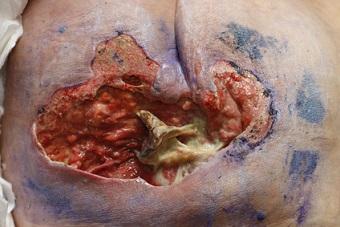Tips and Tricks for Discharging Patients with Wounds
January 16, 2020
Holly M. Hovan MSN, RN-BC, APRN, CWOCN-AP
You might notice the hospital halls seem a little quieter around the holidays, the unit census may be down, and patients may be asking about their discharge plans. The holidays can be a time when patients want to be home (when they're able to).
Institutional Versus Home Wound Care
Often, patients may be admitted to the hospital or the rehab setting for wound care in situations where they or a caregiver cannot complete the required wound care at home. As the wound improves and becomes more manageable, maybe with less frequent dressing changes, the situation may be more manageable at home. However, patients who have wounds may have other comorbidities that may be keeping them in the hospital. This is why it is important to take an interdisciplinary approach to managing the patient, especially when it comes to discharge planning.
Dressing Changes: Challenges and Scenarios in Visiting Nurse Home Care
Wound care in the rehab, long-term care, and hospital settings is part of our role as nurses and caregivers. We have all of the needed tools in our toolkit, are in a controlled environment, and are able to manage the patient's pain that may come along with the dressing change. We have staff trained to complete the wound treatments and who are continuously monitoring the wound for changes. This makes caring for a wound in the hospital setting a bit more controlled and monitored than in a home environment. However, a home environment is often healing for many reasons… it's comfortable, patients know their surroundings, and they have access to familiar and home-cooked foods. It's important to weigh the risks and the benefits, look at the entire picture, and formulate a holistic and safe plan of care before discharging a patient home with a wound.
Planning for Home Wound Care
Going home with a wound may be challenging at times, but depending on the wound, the amount of drainage, and the home environment and support, a plan for home going may be feasible. Going home with a wound is a decision that the patient and the interdisciplinary team will need to make together based on many variables, including the availability of a support system at home and whether or how often home health care may be needed. Factors such as supplies needed to complete the wound care, appropriate storage of the supplies, and sterile versus clean environments will need to be explored and discussed with the team. Nutrition at home is also important because protein helps wounds to heal and vitamin C plays a role in collagen formation, which is vital to the wound healing process.
Patient Education and Advocacy
As nurses, we are often the doctor's eyes and ears and the patient's advocate. However, we always want to encourage our patients to advocate for themselves whenever they are able to. The following are some things patients should consider asking when wondering about a discharge to home with a wound:
- Can I take a shower with my dressing off?
- Can I wash the wound with soap and water, or do I need to use a wound cleanser?
- What are the steps I should follow if the dressing dislodges?
- When should I call the provider?
Education using the teach-back method, ensuring availability of wound care supplies, arranging home health care involvement (when needed), discussing follow-up plans, and reporting to the emergency room with any signs or symptoms of infection are all topics that should be discussed before the patient goes home with a wound. Additionally, the areas of the Braden Scale for Predicting Pressure Sore Risk© (sensory perception, moisture, activity, mobility, nutrition, and friction and shear) should be explored as they apply to the home setting.
Conclusion
Being in the hospital with a wound and being at home with a wound can be very different. Ensuring that the patient has everything in place to be successful with wound management at home is important. As always, it is key to remember that we are treating the whole patient, not just the hole in the patient!
About the Author
Holly is a board certified gerontological nurse and advanced practice wound, ostomy, and continence nurse coordinator at The Department of Veterans Affairs Medical Center in Cleveland, Ohio. She has a passion for education, teaching, and our veterans. Holly has been practicing in WOC nursing for approximately six years. She has much experience with the long-term care population and chronic wounds as well as pressure injuries, diabetic ulcers, venous and arterial wounds, surgical wounds, radiation dermatitis, and wounds requiring advanced wound therapy for healing. Holly enjoys teaching new nurses about wound care and, most importantly, pressure injury prevention. She enjoys working with each patient to come up with an individualized plan of care based on their needs and overall medical situation. She values the importance of taking an interprofessional approach with wound care and prevention overall, and involves each member of the health care team as much as possible. She also values the significance of the support of leadership within her facility and the overall impact of great teamwork for positive outcomes.
The views and opinions expressed in this content are solely those of the contributor, and do not represent the views of WoundSource, HMP Global, its affiliates, or subsidiary companies.











